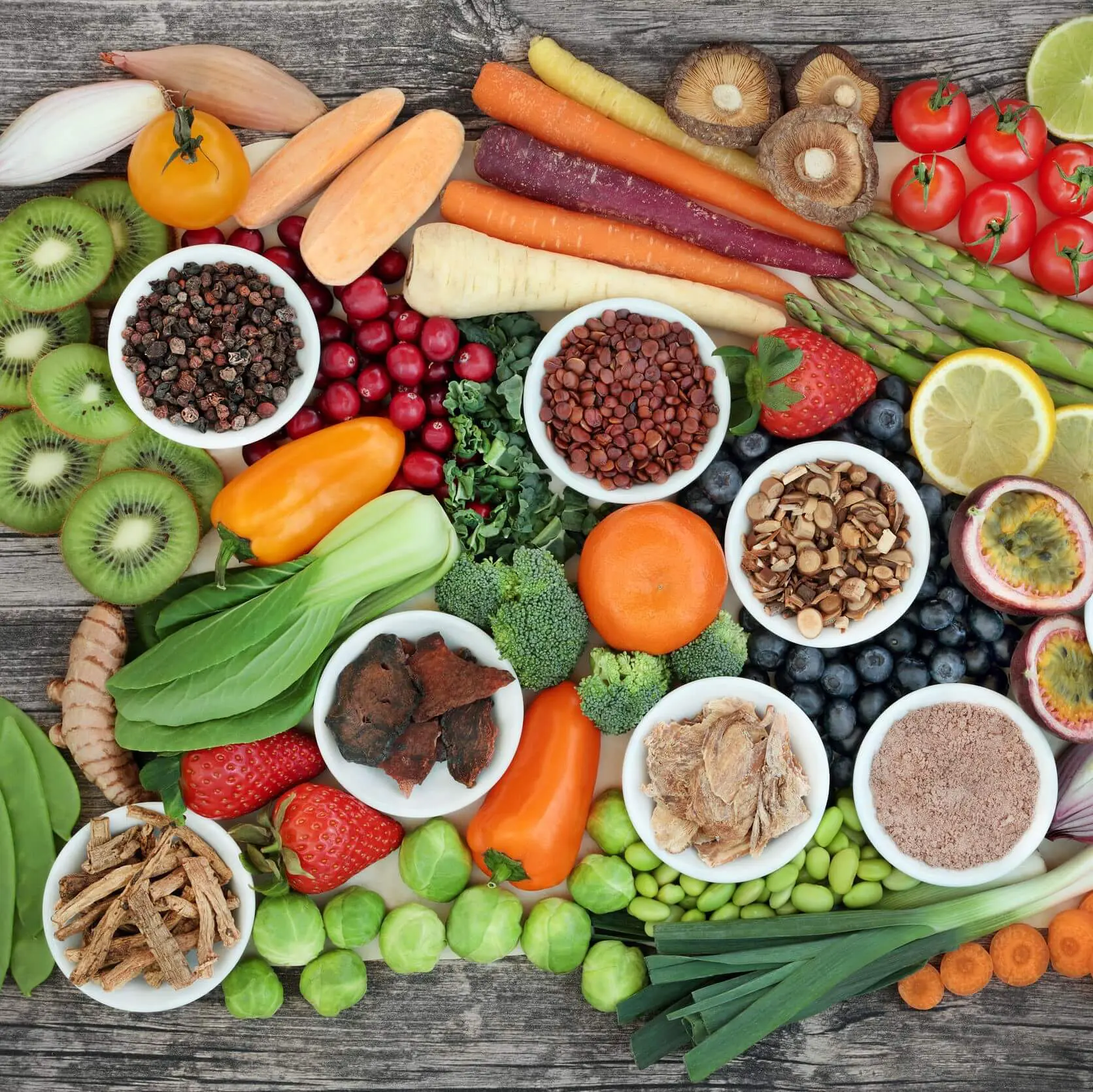
Healthy Eating: 4 Steps to Get Past Barriers You See
If you follow nutrition news, you’ve no doubt heard that whether your aim is lower risk of cancer, heart disease, or type 2 diabetes, or simply to protect overall health, recommendations with the most solid research base recommend a switch from the typical current American eating pattern to one that includes more plant foods. As simple as that is in concept, people sometimes tell me that actually making the swap in proportions of what’s on their plates is easier to talk about than to put into practice.

French Lentil Salad with Cherry Tomatoes
♦ Recipe below from
Sharon Palmer, RDN ♦
(Photo credit
© Heather Poire)
Today’s Smart Bytes® addresses that problem. I’ve asked my friend and colleague, Sharon Palmer, RDN, to share tips to surmount some of the barriers people commonly see to shifting to healthy eating patterns. Ms. Palmer is the author of two books loaded with information and fabulous recipes for plant-based eating. Her first book, The Plant-Powered Diet, has been a delightful part of my cookbook collection, and her new book, Plant-Powered for Life, will doubtless be the same. Her perspective combines the tastes of a “foodie”, the nutrition knowledge of a Registered Dietitian Nutritionist (RDN) and the practical experience of a busy working mom who is “walking the talk” as she feeds her family.
Whether you look at the DASH Diet, originally created to protect heart health; the American Institute for Cancer Research New American Plate, aimed at reducing cancer risk; or the Mediterranean eating pattern or federal MyPlate pattern, recommended as examples of overall healthy eating; a common thread is the shift to more plant foods as a meal’s focus. You might create this sort of eating pattern with meatless meals – once or twice a week, or all the time – or with meals that simply give vegetables, fruits, whole grains and beans the largest real estate on your plate. The point is shifting away from the current American style of eating, which tends to make meat the star of the meal, with vegetables and potatoes present as supporting cast only, and often in less-than-healthy deep-fried or other fat-laden form.
Let’s see how you might hurdle barriers you see:
Do plant-based meals take more time to prepare?
There’s a common misperception that if you eat plant-based meals, you’ll spend more time in the kitchen. While it’s true that you can get really gourmet and create amazing meals that require hours in the kitchen, this doesn’t have to be the case every day! Plant-based cooking can be as easy as veggie taco night with beans, whole grain tortillas, and an assortment of veggies; or a vegetarian chili with cornbread and coleslaw. Many plant-based recipes are quite easy to make, such as a tofu vegetable stir-fry with brown rice.If you are in a rush, make simple meals during the week, and then save time for trying a new plant-based recipe on the weekends. The thing about plant-based eating is that it can be so creative and fun, so it is part of the joy to try a few new things, such as a Vietnamese noodle soup or quinoa stuffed squash.
For people who aren’t accustomed to cooking many vegetables, are special skills or tricks needed for making plant-based meals?
While I don’t think you need to go to culinary school to become a good plant-based cook, a few skills are helpful.
- Chopping. A plant-based diet should be rich in veggies, so that means you should be spending more time chopping and slicing all of these wonderful plants. Invest in a good set of knives and a cutting board. You may also want to try a mandolin, which is great for slicing thin, ribbon like slices. It’s important to avoid throwing away parts of the plant—peels, stems, leaves—that are edible. However, if you’re short on time, supermarkets now carry many varieties of pre-sliced fresh veggies that you can use for recipes.
- Flavoring with Spices and Herbs. Don’t be afraid to get friendly with spices and herbs in plant-based cooking! Start collecting a new spice or herb to add to your spice shelf on each shopping trip, and grow fresh herbs in a pot. My “must-haves” are turmeric, cumin, basil, oregano, rosemary, cinnamon, cardamom, nutmeg, cilantro, parsley, dried mustard, paprika, and black pepper. Include them as you sauté veggies, whisk together vinaigrettes, and simmer side dishes and beans.
- Using Your Slow-Cooker. This is your ally in plant-based cooking, as you can just toss in some soaked beans, whole grains, vegetables, seasoning, and vegetable broth, turn on the button, and you’ll have an amazing meal waiting at the end of the day.
I can’t stick with healthy eating efforts that mean bland, boring food. Won’t I miss out on flavor with plant-focused eating?
Absolutely not! There are an estimated 40,000 edible plant species on the planet—and each species has sometimes thousands of varieties. Just think how many tomatoes and beans there are! You can use all of these varieties to inspire tremendous variety and flavor in your diet.
I encourage people to turn to ethnic foods to inspire plant-based cooking. Most indigenous cultures throughout the world eat a plant-based diet, and they have cultivated amazing flavorful foods, such as Indian dal featuring simmered lentils with spices, Caribbean beans and rice with sofrito, Mediterranean hummus with pita bread, and North African vegetable couscous. How can anyone describe these foods as boring!
How do you respond to people who think that plant-focused eating is too expensive? Do you think it costs more to eat a plant-based diet?
While it may seem like it is more costly, a plant-based diet can be economical. Animal protein is the most expensive item on the menu, so by replacing that with legumes, you can save a huge amount on your grocery bill. Whole grains, such as farro, wheatberries, and oats, are also a bargain.
Also, by focusing on fruits and vegetables that are local and seasonal, you can save money. For example, you don’t have to buy raspberries in January—save those for the summer time when they are available in your local area. Turn to frozen fruits and vegetables more in the off-season, or those that are in season, such as citrus and winter squash.
French Lentil Salad with Cherry Tomatoes (pictured above)
Sharon Palmer is sharing this recipe from her latest book, noting: This simple salad, seasoned with a French vinaigrette, is a classic dish in France. It makes a wonderful, protein-rich highlight of any meal. Because the flavors continue to meld, it’s also great the next day.
♦ Active preparation time: 15 minutes
♦ Total preparation time: 30 minutes (not including chilling time)
Makes 6 servings (about 1 cup each)
1 pound (454 g) dried lentils (or 3 cups cooked; see Note)
4 cups (948 ml) water
2 teaspoons reduced sodium vegetable broth base
4 celery stalks, diced (160 g or about 1½ cups)
1½ cups (224 g) cherry tomatoes, halved
2 medium shallots, finely diced
¼ cup (15 g) packed chopped fresh parsley
1½ tablespoons extra virgin olive oil
2 teaspoons Dijon mustard
2 tablespoons red wine vinegar
1 teaspoon herbes de Provence
Freshly ground black pepper, to taste
1 medium garlic clove, minced
Pinch of sea salt, optional
1. Place the lentils, water, and broth base in a pot. Cover and bring to a boil over medium-high heat. Reduce the heat to medium and cook for 15 to 20 minutes, until the lentils are tender but firm.
2.Remove from the heat, drain any remaining liquid, and transfer the lentils to a large bowl. Chill for at least 30 minutes.
3. Stir in the celery, tomatoes, shallots, and parsley.
4. In a small dish, make the dressing by whisking together the olive oil, mustard, vinegar, herbes de Provence, black pepper, and garlic.
5. Add the dressing to the lentil mixture and toss. Taste and season with sea salt, if desired. Chill until serving time.
Note: If you’re in a rush, use precooked, refrigerated lentils, available at many stores. Although a classic French lentil salad uses lentils du puys (small, dark green lentils), try other varieties for a colorful twist, such as yellow, beluga (black), or multicolored lentils.
Variation: Substitute cooked beans, such as white, fava, or cranberry beans, for the lentils.
Per Serving: 136 calories, 8 g protein, 19 g carbohydrate, 4 g fat, .5 g saturated fat, 4 g fiber, 3 g sugar, 55 mg sodium
From Plant-Powered for Life: Eat Your Way to Lasting Health with 52 Simple Steps and 125 Delicious Recipes. Copyright © 2014 Sharon Palmer. Reprinted by permission of the publisher, The Experiment.
Resources
You can get lots of recipes for plant-focused eating from Sharon Palmer’s website, http://sharonpalmer.com/recipes.php . Here are complete details on her books:
♦ The Plant-Powered Diet: The Lifelong Eating Plan for Achieving Optimal Health, Beginning Today (published by The Experiment, 2012)
♦ Plant-Powered for Life: Eat Your Way to Lasting Health with 52 Simple Steps and 125 Delicious Recipes (published by The Experiment, 2014)
Do you want more help on the art of making healthful, plant-focused meals delicious? McCormick (known for spices) offers several great resources, including Flavor MyPlate and 30 Ways in 30 Days, which provide specific suggestions to help you add flavor to various vegetables, grains and other healthful foods without salt, unhealthy fats or excess calories.
Are you daunted by thoughts that you lack necessary cooking skills? Check the videos by the extraordinary Mollie Katzen on her Let’s Get Cooking website. It’s a companion to her cookbook of the same name, which targets entry-level cooks who want delicious food. In the website’s left sidebar, click on “Ingredients” for videos on how to prepare garlic, ginger, mushrooms, cauliflower and more.
Do you need further convincing that a plant-focused eating pattern won’t strain your budget? The Choose MyPlate website offers a variety of budget-friendly tips.
*Full disclosure: I requested this interview with Sharon Palmer because of her extensive experience with plant-focused cooking. She neither paid, nor was paid, to be featured here.
Article by speaker and author @KarenCollinsRD
1 Comments
Leave a Comment
Published : July 29, 2014 | Last Updated: September 27, 2014
Tagged: barriers to healthy eating, budget, cancer prevention, flavoring food, healthy diet, healthy eating, healthy lifestyle, heart health, plant-based diet, recipes, reducing cancer risk, Sharon Palmer RDN, vegetables
Meet the author/educator
I Take Nutrition Science From Daunting to Doable.™
As a registered dietitian nutritionist, one of the most frequent complaints I hear from people — including health professionals — is that they are overwhelmed by the volume of sometimes-conflicting nutrition information.
I believe that when you turn nutrition from daunting to doable, you can transform people's lives.
Accurately translating nutrition science takes training, time and practice. Dietitians have the essential training and knowledge, but there’s only so much time in a day. I delight in helping them conquer “nutrition overwhelm” so they can feel capable and confident as they help others thrive.
I'm a speaker, writer, and nutrition consultant ... and I welcome you to share or comment on posts as part of this community!





[…] Go here to read the rest: <b>Healthy Eating</b>: 4 Steps to Get Past Barriers You See | Smart Bytes […]